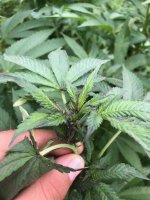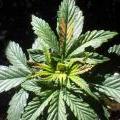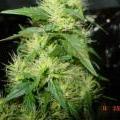Anyone have any idea what this is. A buddy on another forum posted these photos, and my friend where I live is having the EXACT same problem, and has had this problem for the last 4 years, ruining hundreds of plants.
Im thinking its some kind of Cal/Mag, and maybe also sometimes being wet to long.
These are outside, and the same inside plants dont do this, and are on a regular watering/feed schedule vs outside.
Medium is Promix BX. Food. 19-19-19..0-0-60 Granular. Extra Calcitic/Dolomitic Lime.
I believe the nutrients are used up now, and may have some kind of Cal/Mag problem.
But am open to all suggestions.
Thanks in advance.
This is NOT COLD, or BURN.
Just fed them 15.5-0-0 x 4-20-39. Magnesium, and Azomite to see if this helps.
Im thinking its some kind of Cal/Mag, and maybe also sometimes being wet to long.
These are outside, and the same inside plants dont do this, and are on a regular watering/feed schedule vs outside.
Medium is Promix BX. Food. 19-19-19..0-0-60 Granular. Extra Calcitic/Dolomitic Lime.
I believe the nutrients are used up now, and may have some kind of Cal/Mag problem.
But am open to all suggestions.
Thanks in advance.
This is NOT COLD, or BURN.
Just fed them 15.5-0-0 x 4-20-39. Magnesium, and Azomite to see if this helps.





